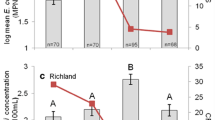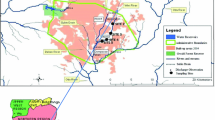Abstract
Many water quality monitoring programs quantify Escherichia coli, an indicator of fecal contamination and potential sewage pollution. However, interpretation of E. coli data can be complex due to abiotic factors that influence its growth and mortality. The goal of this study was to quantify the variability of E. coli in a river and assess the impact of that variability on water quality monitoring study design and sewage pollution source identification. Over 1900 samples were collected and analyzed from 2007 to 2017 in the Norwalk River in Connecticut. Sixty-six percent of the samples collected during weekly to monthly monitoring had E. coli concentrations below 200 CFU/100 mL, indicating that elevated bacteria concentrations were captured infrequently. Patterns observed during daily sampling indicated that the randomization of sampling days within a week may support the identification of pollution sources driven by human behavioral patterns. Spatial autocorrelation in bacteria concentrations was not observed between sites, indicating that the sample locations were not spaced sufficiently close together to be redundant for monitoring. On finer spatial scales however, detection of a known pollution source was found to be challenging at even short distances downstream, with less than 25% of the original source concentration detected at 10 m downstream and less than 10% by 1000 m downstream, suggesting that a high density of study sites may be needed to detect potential sources. These findings can be used to better understand the natural variability of this important indicator organism in freshwater systems, and inform more efficient and effective monitoring.





Similar content being viewed by others
References
Anderson, K. L., Whitlock, J. E., Valerie, J., & Harwood, V. J. (2005). Persistence and differential survival of fecal indicator bacteria in subtropical waters and sediments. Applied and Environmental Microbiology, 71(6), 3041–3048. https://doi.org/10.1128/AEM.71.6.3041.
Boehm, A. B. (2007). Enterococci concentrations in diverse coastal environments exhibit extreme variability. Environmental Science & Technology, 41(24), 8227–8232. https://doi.org/10.1021/es071807v.
Carpenter, S. R., Caraco, N. F., Correll, D. L., Howarth, R. W., Sharpley, A. N., & Smith, V. H. (1998). Nonpoint pollution of surface waters with phosphorus and nitrogen. Ecological Applications, 8(3), 559–568. https://doi.org/10.1890/1051-0761(1998)008[0559:NPOSWW]2.0.CO;2.
Cho, K. H., Cha, S. M., Kang, J.-H., Lee, S. W., Park, Y., Kim, J.-W., & Kim, J. H. (2010). Meteorological effects on the levels of fecal indicator bacteria in an urban stream: a modeling approach. Water Research, 44(7), 2189–2202. https://doi.org/10.1016/j.watres.2009.12.051.
Chudoba, E. A., Mallin, M. A., Cahoon, L. B., & Skrabal, S. A. (2013). Stimulation of fecal bacteria in ambient waters by experimental inputs of organic and inorganic phosphorus. Water Research, 47(10), 3455–3466. https://doi.org/10.1016/j.watres.2013.03.047.
De Guise, S., Maratea, J., Chang, E. S., & Perkins, C. (2005). Resmethrin immunotoxicity and endocrine disrupting effects in the American lobster (Homarus Americanus) upon experimental exposure. Journal of Shellfish Research, 24(3), 781–786. https://doi.org/10.2983/0730-8000(2005)24[781:RIAEDE]2.0.CO;2.
Department of Energy and Environmental Protection. Connecticut Water Quality Standards, Pub. L. No. 22a-426- 1—22a-426–9 (2015). USA. https://eregulations.ct.gov/eRegsPortal/Browse/getDocument?guid = %7BC0A3E155-0100-C1CF-85C3-D3C28F298640%7D
Desai, A. M., & Rifai, H. S. (2010). Concentrations in an Urban Watershed in Texas. Journal of Environmental Engineering, 136(12), 1347–1359. https://doi.org/10.1061/(ASCE)EE.1943-7870.0000290.
Edberg, S. C., Rice, E. W., Karlin, R. J., & Allen, M. J. (2000). Escherichia coli: the best biological drinking water indicator for public health protection. Journal of Applied Microbiology, 88(S1), 106S–116S. https://doi.org/10.1111/j.1365-2672.2000.tb05338.x.
Gilbert, R. O. (1987). Statistical methods for environmental pollution monitoring. New York: Van Nostrand Reinhold Company, Inc..
Ishii, S., Hansen, D. L., Hicks, R. E., & Sadowsky, M. J. (2007). Beach sand and sediments are temporal sinks and sources of Escherichia coli in Lake Superior. Environmental Science & Technology, 41(7), 2203–2209. https://doi.org/10.1021/es0623156.
Ishii, S., Ksoll, W. B., Hicks, R. E., & Sadowsky, M. J. (2006). Presence and growth of naturalized Escherichia coli in temperate soils from lake superior watersheds. Applied and Environmental Microbiology, 72(1), 612–621. https://doi.org/10.1128/AEM.72.1.612-621.2006.
Kaper, J. B., Nataro, J. P., & Mobley, H. L. T. (2004). Pathogenic Escherichia coli. Nature Reviews Microbiology, 2(2), 123–140. https://doi.org/10.1038/nrmicro818.
Koirala, S. R., Gentry, R. W., Perfect, E., Schwartz, J. S., & Sayler, G. S. (2008). Temporal variation and persistence of bacteria in streams. Journal of Environmental Quality, 37(4), 1559–1566. https://doi.org/10.2134/jeq2007.0310.
Leecaster, M. K., & Weisberg, S. B. (2001). Effect of sampling frequency on shoreline microbiology assessments. Marine Pollution Bulletin, 42(11), 1150–1154. https://doi.org/10.1016/S0025-326X(01)00130-8.
Long Island Sound Study. (2017). Long Island Sound - by the numbers. http://longislandsoundstudy.net/about-the-sound/by-the-numbers/. Accessed 18 August 2017
Lynch, P. J. (2017). A field guide to Long Island Sound: coastal habitats, plant life, fish, seabirds, marine mammals, and other wildlife. Yale University Press.
Mallin, M. A., Williams, K. E., Esham, E. C., & Lowe, R. P. (2000). Effect of human development on bacteriological water quality in coastal watersheds. Ecological Applications, 10(4), 1047–1056. https://doi.org/10.1890/1051-0761(2000)010[1047:EOHDOB]2.0.CO;2. Accessed 22 June 2016
Marsalek, J., & Rochfort, Q. (2004). Urban wet-weather flows: sources of fecal contamination impacting on recreational waters and threatening drinking-water sources. Journal of Toxicology and Environmental Health, Part A, 67(20–22), 1765–1777. https://doi.org/10.1080/15287390490492430.
McFeters, G. A., & Stuart, D. G. (1972). Survival of coliform bacteria in natural waters: field and laboratory studies with membrane-filter chambers. Applied Microbiology, 24(5), 805–811 http://aem.asm.org/content/24/5/805.abstract.
NOAA’s National Ocean Service. (2013). What percentage of the American population lives near the coast? https://oceanservice.noaa.gov/facts/population.html. Accessed 18 August 2017
Core Team, R. (2013). R: a language and environment for statistical computing. In R Foundation for Statistical Computing. Vienna: Austria. URL http://www.R-project.org.
Reed, R. H. (1997). Solar inactivation of faecal bacteria in water: the critical role of oxygen. Letters in Applied Microbiology, 24(4), 276–280. https://doi.org/10.1046/j.1472-765X.1997.00130.x.
Rice, E. W., Baird, R. B., Eaton, A. D., & Clesceri, L. S. (Eds.). (2012). Standard methods for the examination of water and wastewater (22nd ed.). Washington, DC: American Public Health Association.
SAS Institute Inc. (2016). JMP Software Version 12. Cary, NC: SAS Institute Inc..
Schilling, K. E., Zhang, Y.-K., Hill, D. R., Jones, C. S., & Wolter, C. F. (2009). Temporal variations of Escherichia coli concentrations in a large Midwestern river. Journal of Hydrology, 365(1), 79–85. https://doi.org/10.1016/j.jhydrol.2008.11.029.
Shibata, T., Solo-Gabriele, H. M., Fleming, L. E., & Elmir, S. (2004). Monitoring marine recreational water quality using multiple microbial indicators in an urban tropical environment. Water Research, 38(13), 3119–3131. https://doi.org/10.1016/j.watres.2004.04.044.
Solo-Gabriele, H. M., Wolfert, M. A., Desmarais, T. R., & Palmer, C. J. (2000). Sources of Escherichia coli in a coastal subtropical environment. Applied and Environmental Microbiology, 66(1), 230–237. https://doi.org/10.1128/AEM.66.1.230-237.2000.
Somarelli, J. A., Makarewicz, J. C., Sia, R., & Simon, R. (2007). Wildlife identified as major source of Escherichia coli in agriculturally dominated watersheds by BOX A1R-derived genetic fingerprints. Journal of Environmental Management, 82(1), 60–65. https://doi.org/10.1016/j.jenvman.2005.12.013.
State of Connecticut. (2017). State of Connecticut Department of Energy and Environmental Protection 2016 integrated water quality report. CT: Hartford.
The Norwalk River Watershed Initiative Committee, HDR HydroQual, & South Western Regional Planning Agency. (2011). The Norwalk river watershed action plan: it’s our watershed – let’s take care of it.
Traister, E., & Anisfeld, S. C. (2006). Variability of indicator bacteria at different time scales in the upper Hoosic River watershed. Environmental Science and Technology, 40(16), 4990–4995. https://doi.org/10.1021/es0601437.
Vaudrey, J. M. P., Alonzo, J., Esposito, A., Johnson, C., Dolan Murphy, M., & Yarish, C. (2013). Evaluation of current community-based monitoring efforts and recommendations for developing a cohesive network of support for monitoring Long Island Sound embayments. Department of Marine Sciences: The University of Connecticut http://digitalcommons.uconn.edu/marine_sci/2.
Webster, L. F., Thompson, B. C., Fulton, M. H., Chestnut, D. E., Van Dolah, R. F., Leight, A. K., & Scott, G. I. (2004). Identification of sources of Escherichia coli in South Carolina estuaries using antibiotic resistance analysis. Journal of Experimental Marine Biology and Ecology, 298(2), 179–195. https://doi.org/10.1016/S0022-0981(03)00358-7.
Wheeler Alm, E., Burke, J., & Spain, A. (2003). Fecal indicator bacteria are abundant in wet sand at freshwater beaches. Water Research, 37(16), 3978–3982. https://doi.org/10.1016/S0043-1354(03)00301-4.
Whitman, R. L., Nevers, M. B., Korinek, G. C., & Byappanahalli, M. N. (2004). Solar and temporal effects on Escherichia coli concentration at a Lake Michigan Swimming Beach. Applied and Environmental Microbiology, 70(7), 4276. https://doi.org/10.1128/AEM.70.7.4276.
Yates, M. V. (1985). Septic tank density and ground-water contamination. Ground Water, 23(5), 586–591. https://doi.org/10.1111/j.1745-6584.1985.tb01506.x.
Acknowledgments
The authors thank Devan Shulby, Richard Harris, and dozens of volunteers and interns who participated in the collection of data for this study. Funding for the collection of data on the Norwalk River was provided by 11th Hour Racing Foundation, Atlantic Clam Farms, City of Norwalk, Copps Island Oysters, Horizon Foundation, Jeniam Foundation, King Industries, Long Island Sound Futures Fund, Newman’s Own Foundation, Norwalk River Watershed Association, NRG – Devon, Social Venture Partners of Connecticut, town of Ridgefield, town of Wilton, and Trout Unlimited - Mianus Chapter.
Author information
Authors and Affiliations
Corresponding author
Ethics declarations
Conflict of interest
The authors declare that they have no conflicts of interest.
Additional information
Publisher’s note
Springer Nature remains neutral with regard to jurisdictional claims in published maps and institutional affiliations.
Rights and permissions
About this article
Cite this article
Crosby, S.C., Spiller, N.C., Tietz, K.E. et al. Temporal and spatial variability of instream indicator bacteria (Escherichia coli) and implications for water quality monitoring. Environ Monit Assess 191, 745 (2019). https://doi.org/10.1007/s10661-019-7930-1
Received:
Accepted:
Published:
DOI: https://doi.org/10.1007/s10661-019-7930-1




